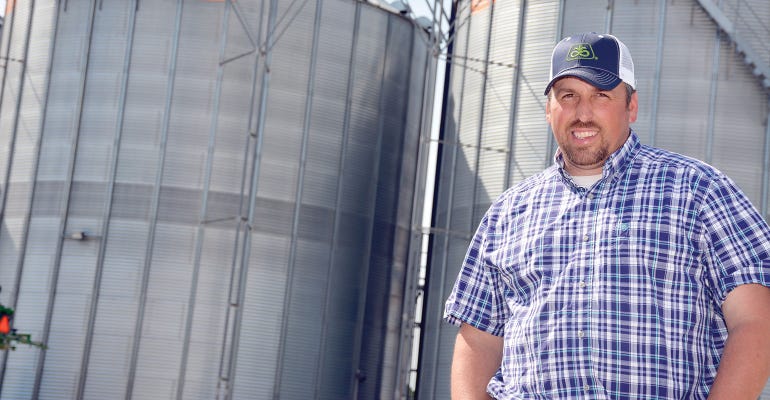
John Verell III sets a high bar for corn, soybean and wheat yields. He usually hits that mark and expects to do so this year despite some planting challenges that started last fall with wheat.
His wheat target yield is the low 90-bushel range. He looks for around 50 bushels per acre on dryland soybeans and mid- to high-60 bushels on irrigated beans. Irrigated corn goal is 300 bushels per acre, and he targets 200 for dryland.
“My five-year average on irrigated corn is 270 bushels,” Verell, says. “Every year something is just a little bit off. My 10-year average on wheat is 95 bushels.”
He typically hits that soybean mark, too.
“We will need it this year,” he says. “With weather problems and the market, it’s been tough to stay positive, but the only way to be profitable is to make high yields.”

Planting Challenges
The biggest challenge he’s faced with the 2019 crop has been “getting it planted,” during breaks in the persistent rain that has drenched his Jackson, Tenn., operation since last fall.
“My second biggest challenge,” he adds, “will be to make a profit.”
On May 6, he was about a day-and-a-half from completing planting. “We would be through by now if we hadn’t had rain last Saturday.”
He was hoping to miss another predicted rain two days later and get the last few acres of soybeans in the ground. That’s not counting the beans he will double-crop behind wheat in early June.
“We’ve had a tough start,” Verell says. “This is the latest we ever started spring planting.”
He says he passed up a few days of planting in what he terms “questionably dry enough conditions. Soil temperatures were still too cool.”
He says he was fortunate to get most of his wheat planted on time. “Early-planted wheat could be some of the best we’ve ever had. Wheat stands in fields planted after Oct. 15 are a lot thinner.”
He later drove out to one of his better wheat fields to see a uniform stand that was headed, clean and virtually disease free. Yield target on that field seemed more than possible.
Controlling What He Can
Verell concedes that he can do little about either the weather or the market, so he concentrates on managing what he can control.
“We will keep regular management practices the best we can,” he says. “We plant the best varieties and try to get the most uniform stand possible. We want to get the crop off to the best start we can and manage from there. We apply necessary inputs at the right time.”
Fungicide application is routine. “We apply fungicide on everything,” Verell says. “Year in and year out, we get a benefit from fungicides. They keep plants healthy longer and that promotes heavier corn kernels and bigger soybean seed. We see a direct correlation with bigger kernels and seed and high yields.
“The bushels we add with a fungicide at least pay for the application, and when we get rain, the crop does not deteriorate as much.”
He says fungicides also limit damage from wheat head scab, “one of our biggest enemies. We can lose 15 to 20 percent. And if toxin levels are high enough, we can have trouble selling it.”
He says protecting a crop from toxins is especially important with low prices. “It seems like when prices are down is when we get head scab or aflatoxin.”
Preemptive on Weeds
He takes a preemptive approach to weeds, too. “We want to start clean and stay clean,” he says. Planting soybeans double-crop behind wheat gives him a head start. “In soybeans behind wheat, 50 percent of the battle is already fought because of the residue.”
The wheat crop and the straw limit weed emergence. “We also use pre-emergence and residual herbicides. And we use dicamba-tolerant soybeans varieties and will use the dicamba technology if we need to.”
He treats with other products first. He hopes “weeds never come up. But we use post-emergence applications up to layby with two types (modes of action) of residual herbicides. Pigweed is the big one we watch for.”
Cover Crop Advantages
Wheat stubble adds residue, protects soil and limits weed pressure. “We also have some land in cover crops. If we have something growing on the land all year, we are better off.”
He adds that cover crops keep soil from blowing away. “It also means less prep work and it holds moisture.”
He’s using a five-species cover crop mix that includes a legume (clover) and radish. “We plant the cover a bit late so the radish may not have time to grow much.
“We also rotate 50/50 with corn and soybeans and rarely plant corn behind corn.”
Verell says he can do little about commodity prices but does try to take advantage of any price rallies to improve the odds. Storage facilities help.

On-Farm Storage
“We store it all and try not to haul anything to the river or the elevator unless we sold a pre-harvest contract. We try to hold until December.”
He says the advantage of on-farm storage includes the marketing aspect that allows them to “roll the futures contract and improve the basis. Sometimes we can pick up 10 cents to 20 cents by holding to December.”
Storage improves harvest efficiency, too. Without storage, Verell says he would need seven trucks to service combines and move corn to the river or the elevator. “With storage, we can run two combines with four trucks and take grain to the bins.”
Verell, 36, farms with his father, John Allen Jr., and his grandfather, John Allen Sr.
“Granddad moved here in the mid-1960s,” Verell says, after managing a farm in Arkansas where he met his wife picking cotton. “He started the farm with a couple hundred acres and started building from there. He thought west Tennessee had some good soil.
“I am the third generation,” Verell adds. “But Granddad made us who we are.”
He thinks his six-year old daughter may be the next to operate the farm. “She loves it and says she wants to farm or be a vet. She likes to stay outside.”
As Verell works to finish planting the 2019 crop, he hopes to avoid what he considers would be the worst scenario — a bad west Tennessee crop and good production everywhere else.
But he knows that’s beyond his control, so he’s committed to doing all he can to reach those high benchmarks again this year. He’ll have an idea of the season’s prospects when he starts wheat harvest in a few weeks.
About the Author(s)
You May Also Like






